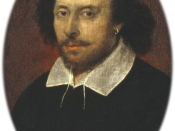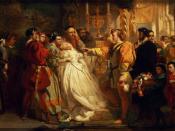In Virginia Woolf's novel "A Room of One's Own", Woolf puts forth the argument that "it would have been impossible, completely and entirely, for any woman to have written the plays of Shakespeare" (Woolf 60), as women of that time neither had the finances nor the space where they could sit down and write effectively. Along with this convincing argument, Shakespeare's constant portrayal of women as second class citizens lacking in personality cannot be ignored. Even though Elizabethan values were rooted in a patriarchal system, a woman playwright would not have portrayed the members of her own sex in such a degrading manner as Shakespeare did. The depiction of women in Shakespeare's comedy, "Much Ado About Nothing" reflects a common pattern of imagery. In this play, Shakespeare demonstrates that women are objects, that their worth lies solely in their chastity and purity, and that women, on the whole, lack in personality.
He further illustrates that women who do not lack the strength of character are of no use to society until they are subdued.
In Shakespeare's play, male characters objectify women. In the opening scene of "Much Ado About Nothing", Claudio, a young lord of Florence, professes that he is in love with Hero, the daughter of Leonato, governor of Messina. The audience feels that it is Hero's physical beauty as well as her innocent and quiet nature that attracts Claudio to her. Before Claudio has even spoken to Hero he asks his friend Benedick: "Is she not a modest young lady?" (Much Ado About Nothing 1.1. 165) Claudio is not interested in Hero's personality. He further seeks his friend's approval when he questions Benedick: "Can the world buy such a jewel?" (1.1. 181) Not only does Claudio need Benedick to validate Hero's worth, he equates her with a...



Much Pleasure About Something
Kia ora Bob from High School Teacher Tanya down here in Waitakere City, Auckland New Zealand (look it up in the atlas!) I like this essay very much. It has a clear structure with cogent points advanced in the introduction. This is followed with strong body paragraphs showing good insight and evidence.
I am fond of your use of Virginia Woolf's reference to the female crux...see clearly but be alienated! Gosh I am glad to be a woman of these times.
I have copied your essay and will show it to my students as an exemplar. I teach a class of gifted 16 year olds, and they are approaching this work through Branagh's film adaptation. The combination of script and cinematographic techniques make for a powerful vehicle to expose the patriachal power theme...my cosseted little babies are amazed at the extent of the gender imbalance in this play!
Thank you very much for your work...I look forward to reading your other submissions.
Arohanui
Tanya T
0 out of 0 people found this comment useful.